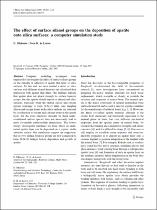 ResearchSpace
ResearchSpace
Effect of surface silanol groups on the deposition of apatite onto silica surfaces: a computer simulation study
JavaScript is disabled for your browser. Some features of this site may not work without it.
- ResearchSpace
- →
- Research Publications/Outputs
- →
- Journal Articles
- →
- View Item
| dc.contributor.author |
Mkhonto, D

|
|
| dc.contributor.author |
De Leeuw, NH

|
|
| dc.date.accessioned | 2009-05-11T14:29:25Z | |
| dc.date.available | 2009-05-11T14:29:25Z | |
| dc.date.issued | 2008-01 | |
| dc.identifier.citation | Mkhonto, D and De Leeuw, NH. 2008. Effect of surface silanol groups on the deposition of apatite onto silica surfaces: a computer simulation study. Journal of Materials Science Materials in Medicine. Vol. 19, pp 203-216 | en |
| dc.identifier.issn | 0957-4530 | |
| dc.identifier.uri | http://hdl.handle.net/10204/3372 | |
| dc.description | Copyright: 2007 Springer Science and Business Media | en |
| dc.description.abstract | Computer modelling techniques were employed to investigate the effect of surface silanol groups on the strength of adhesion of apatite thin films to silica surfaces. To this end, the researchers have studied a series of silica surfaces with different silanol densities and calculated their interaction with apatite thin films. The findings indicate that apatite does not attach strongly to surface hydroxy groups, but that apatite should deposit at dehydrated silica surfaces, especially when the surface silicon and oxygen species rearrange to form O–Si–O links. Any dangling silicon and oxygen bonds at the silica surfaces are saturated by coordination to oxygen and calcium atoms in the apatite layer, but the extra reactivity afforded by these under coordinated surface species does not necessarily lead to more favourable substrate/film interactions. The lowest energy silica/apatite interfaces are those where an undistorted apatite layer can be deposited on a regular, stable substrate surface. The researchers’ simulations support the suggestion, that in vivo surface hydroxy groups are first condensed to form O–Si–O bridges before deposition and growth of apatite | en |
| dc.language.iso | en | en |
| dc.publisher | Springer Science and Business Media | en |
| dc.subject | Silanol groups | en |
| dc.subject | Apatite | en |
| dc.subject | Silica | en |
| dc.subject | Computer modelling | en |
| dc.subject | Hydroxy groups | en |
| dc.title | Effect of surface silanol groups on the deposition of apatite onto silica surfaces: a computer simulation study | en |
| dc.type | Article | en |
| dc.identifier.apacitation | Mkhonto, D., & De Leeuw, N. (2008). Effect of surface silanol groups on the deposition of apatite onto silica surfaces: a computer simulation study. http://hdl.handle.net/10204/3372 | en_ZA |
| dc.identifier.chicagocitation | Mkhonto, D, and NH De Leeuw "Effect of surface silanol groups on the deposition of apatite onto silica surfaces: a computer simulation study." (2008) http://hdl.handle.net/10204/3372 | en_ZA |
| dc.identifier.vancouvercitation | Mkhonto D, De Leeuw N. Effect of surface silanol groups on the deposition of apatite onto silica surfaces: a computer simulation study. 2008; http://hdl.handle.net/10204/3372. | en_ZA |
| dc.identifier.ris | TY - Article AU - Mkhonto, D AU - De Leeuw, NH AB - Computer modelling techniques were employed to investigate the effect of surface silanol groups on the strength of adhesion of apatite thin films to silica surfaces. To this end, the researchers have studied a series of silica surfaces with different silanol densities and calculated their interaction with apatite thin films. The findings indicate that apatite does not attach strongly to surface hydroxy groups, but that apatite should deposit at dehydrated silica surfaces, especially when the surface silicon and oxygen species rearrange to form O–Si–O links. Any dangling silicon and oxygen bonds at the silica surfaces are saturated by coordination to oxygen and calcium atoms in the apatite layer, but the extra reactivity afforded by these under coordinated surface species does not necessarily lead to more favourable substrate/film interactions. The lowest energy silica/apatite interfaces are those where an undistorted apatite layer can be deposited on a regular, stable substrate surface. The researchers’ simulations support the suggestion, that in vivo surface hydroxy groups are first condensed to form O–Si–O bridges before deposition and growth of apatite DA - 2008-01 DB - ResearchSpace DP - CSIR KW - Silanol groups KW - Apatite KW - Silica KW - Computer modelling KW - Hydroxy groups LK - https://researchspace.csir.co.za PY - 2008 SM - 0957-4530 T1 - Effect of surface silanol groups on the deposition of apatite onto silica surfaces: a computer simulation study TI - Effect of surface silanol groups on the deposition of apatite onto silica surfaces: a computer simulation study UR - http://hdl.handle.net/10204/3372 ER - | en_ZA |





